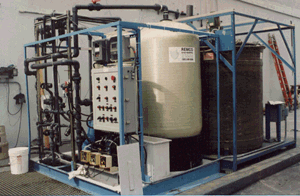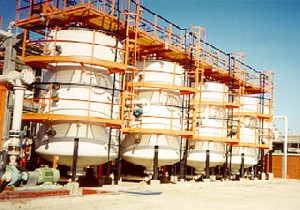 Engineering Services
Top of page
Engineering Services
Top of page

 Products -
Biosorbents
Top of page Products -
Biosorbents
Top of page

 Equipment
Top of page Equipment
Top of page

     |
|
 Biosorption
Pilot Systems (BeePS) are of different sizes as required.
They use a range of sorption columns from small laboratory columns
to a man size. Advanced BeePS are partially automated, self-standing
modules for the sorption process containing all the operating
elements: columns, tanks, pumps, flow-control valves and
plumbing. Biosorption
Pilot Systems (BeePS) are of different sizes as required.
They use a range of sorption columns from small laboratory columns
to a man size. Advanced BeePS are partially automated, self-standing
modules for the sorption process containing all the operating
elements: columns, tanks, pumps, flow-control valves and
plumbing.
 Apart from the standard sorption column
operation, there could be fluidized bed or mixed-tank
sorption operations that allow working with suspensions feeds
containing particles. Again, all components are standard
equipment. Apart from the standard sorption column
operation, there could be fluidized bed or mixed-tank
sorption operations that allow working with suspensions feeds
containing particles. Again, all components are standard
equipment.
 Regeneration of spent biosorbents is usually done in
situ inside the equipment. When completely spent biosorbents are
to be disposed of after multiple-use cycles, they are washed clean
in the last cycle and landfilled or incinerated - they are safe and
biodegradable.
Regeneration of spent biosorbents is usually done in
situ inside the equipment. When completely spent biosorbents are
to be disposed of after multiple-use cycles, they are washed clean
in the last cycle and landfilled or incinerated - they are safe and
biodegradable.
|

|
|
 Equipment:
One of the key advantages of the biosorption process is that it uses
a completely standard equipment easily available in all sizes
and modifications, readily order from specialized manufacturers and
assembled by the Company in an appropriate format as
required. Equipment:
One of the key advantages of the biosorption process is that it uses
a completely standard equipment easily available in all sizes
and modifications, readily order from specialized manufacturers and
assembled by the Company in an appropriate format as
required.
 The Company engineers and technicians look after
equipment sizing, ordering, assembly, modification, testing and
piloting - even operation, if required by the Client. The Company engineers and technicians look after
equipment sizing, ordering, assembly, modification, testing and
piloting - even operation, if required by the Client.
 Supplying and assembling the equipment provides a small
portion of Company revenues. Supplying and assembling the equipment provides a small
portion of Company revenues.
 The Company aims
at delivering fully engineered turn-key effluent processing plants -
with operation supervision and/or full operation. The Company aims
at delivering fully engineered turn-key effluent processing plants -
with operation supervision and/or full operation.
|
 |
  Treatability Studies
Top of page Treatability Studies
Top of page

As one step of studying and remedying the wastewater
problem, treatability studies could become expensive. The Company
know-how and thorough knowledge of the (sorption) process minimizes the
time and expense of effluent treatability studies. In fact, we do not
hesitate to NOT recommend the biosorption detoxification step if it is not
required for the overall treatment scheme to be effective.
Top of page
.gif) |